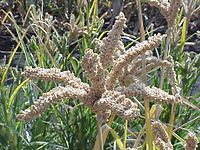
Photo from wikipedia
Intercropping is considered a promising system for boosting crop productivity. However, intercropping usually requires higher inputs of resources that emit more CO2. It is unclear whether an improved agricultural pattern… Click to show full abstract
Intercropping is considered a promising system for boosting crop productivity. However, intercropping usually requires higher inputs of resources that emit more CO2. It is unclear whether an improved agricultural pattern could relieve this issue and enhance agricultural sustainability in an arid irrigation area. A field experiment using a well-designed agricultural practice was carried out in northwest China; reduced tillage, coupled with wheat straw residue retention measures, was integrated with a strip intercropping pattern. We determined the crop productivity, water use, economic benefits, and carbon emissions (CEs). The wheat-maize intercropping coupled with straw covering (i.e., NTSI treatment), boosted grain yield by 27–38% and 153–160% more than the conventional monoculture of maize and wheat, respectively, and it also increased by 9.9–11.9% over the conventional intercropping treatment. Similarly, this pattern also improved the water use efficiency by 15.4–22.4% in comparison with the conventional monoculture of maize by 45.7–48.3% in comparison with the conventional monoculture of wheat and by 14.7–15.9% in comparison with the conventional intercropping treatment. Meanwhile, NTSI treatment caused 7.4–13.7% and 37.0–47.7% greater solar energy use efficiency than the conventional monoculture of maize and wheat, respectively. Furthermore, the NTSI treatment had a higher net return (NR) by 54–71% and 281–338% and a higher benefit per cubic meter of water (BPW) by 35–51% and 119–147% more than the conventional monoculture of maize and wheat, respectively. Similarly, it increased the NR and BPW by 8–14% and 14–16% in comparison with the conventional intercropping treatment, respectively. An additional feature of the NTSI treatment is that it reduced CEs by 13.4–23.8% and 7.3–17.5% while improving CE efficiency by 62.6–66.9% and 23.2–33.2% more than the conventional monoculture maize and intercropping treatments, respectively. We can draw a conclusion that intercropping maize and wheat, with a straw covering soil surface, can be used to enhance crop production and NRs while effectively lowering CO2 emissions in arid oasis irrigation region.
Journal Title: Frontiers in Plant Science
Year Published: 2018
Link to full text (if available)
Share on Social Media: Sign Up to like & get
recommendations!